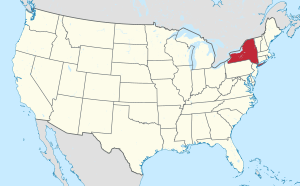Honeoye Falls, New York facts for kids
Quick facts for kids
Honeoye Falls
|
|
|---|---|

A small waterfall on Honeoye Creek, which gave the town its name
|
|

Location in Monroe County and the state of New York.
|
|

Location of New York in the United States
|
|
| Country | United States |
| State | New York |
| County | Monroe |
| Township | Mendon |
| Incorporated | 1791 |
| Area | |
| • Total | 2.60 sq mi (6.72 km2) |
| • Land | 2.54 sq mi (6.59 km2) |
| • Water | 0.05 sq mi (0.13 km2) |
| Elevation | 668 ft (204 m) |
| Population
(2020)
|
|
| • Total | 2,706 |
| • Density | 1,064.10/sq mi (410.83/km2) |
| Time zone | UTC-5 (EST) |
| • Summer (DST) | UTC-4 (EDT) |
| ZIP code |
14472
|
| Area code(s) | 585 |
| FIPS code | 36-35364 |
| Website | http://www.villageofhoneoyefalls.org/ |
Honeoye Falls (pronounced HUN-ee-oy) is a small village in Monroe County, New York, United States. It is part of the town of Mendon. In 2020, about 2,706 people lived there. The village gets its name from a small waterfall on Honeoye Creek, which flows right through it. The name "Honeoye" comes from the Seneca word ha-ne-a-yah, which means "lying finger" or "where the finger lies." This name comes from an old local story about a Native American who had to cut off his finger after a rattlesnake bite.
Contents
History of Honeoye Falls
How the Village Began
Honeoye Falls was started in 1791 by a person named Zebulon Norton. He bought a large piece of land, about 1,820 acres (7.36 square kilometers), for a very low price. He then built a grist mill, which grinds grain into flour, and later a sawmill near the waterfall on Honeoye Creek. Because of his mills, the area was first known as Norton Mills.
Important Historic Buildings
In 1827, another mill was built by Hiram Finch. This mill became known as the Lower Mill to tell it apart from Norton's first mill. The Lower Mill is very important historically. On May 17, 1973, it was added to the National Register of Historic Places. This list includes places that are important to the history of the United States.
Other historic spots in Honeoye Falls that are also on the National Register of Historic Places include:
- The Honeoye Falls Village Historic District (a whole area with many old buildings)
- St. John's Episcopal Church
- The Totiakton Site
- The United States Post Office
Geography of Honeoye Falls
Where is Honeoye Falls?
Honeoye Falls is located right on the falls of Honeoye Creek. This creek is the main water flow coming out of Honeoye Lake.
The village is in the very southeastern part of Monroe County. It is about 13 miles (21 kilometers) away from the City of Rochester. The village covers a total area of about 2.6 square miles (6.7 square kilometers).
People of Honeoye Falls
Population Changes Over Time
| Historical population | |||
|---|---|---|---|
| Census | Pop. | %± | |
| 1870 | 921 | — | |
| 1880 | 1,098 | 19.2% | |
| 1890 | 1,128 | 2.7% | |
| 1900 | 1,175 | 4.2% | |
| 1910 | 1,169 | −0.5% | |
| 1920 | 1,107 | −5.3% | |
| 1930 | 1,187 | 7.2% | |
| 1940 | 1,274 | 7.3% | |
| 1950 | 1,460 | 14.6% | |
| 1960 | 2,143 | 46.8% | |
| 1970 | 2,248 | 4.9% | |
| 1980 | 2,410 | 7.2% | |
| 1990 | 2,340 | −2.9% | |
| 2000 | 2,595 | 10.9% | |
| 2010 | 2,674 | 3.0% | |
| 2020 | 2,706 | 1.2% | |
| U.S. Decennial Census | |||
In 2020, the village of Honeoye Falls had 2,706 people living there. There were 1,195 households and 689 families.
Who Lives in Honeoye Falls?
Based on the 2000 census, most people in Honeoye Falls were White (about 97%). About 1% were African American, and less than 1% were Native American or Asian. About 1% of the population was Hispanic or Latino.
In 2000, about 30% of households had children under 18 living with them. The average age of people in the village was 41 years old.
Education in Honeoye Falls
Local Schools
Public schools in Honeoye Falls are part of the Honeoye Falls-Lima Central School District. This district serves students from Honeoye Falls and the nearby town of Lima.
The schools located within the village itself are:
- Honeoye Falls-Lima Senior High School
- Honeoye Falls-Lima Middle School
- Manor Intermediate School
The Lima Primary School is also part of the district, but it is located in the town of Lima. The school mascot for the district is the Cougar.
Most adults (93.2%) in Honeoye Falls who are 25 years or older have a high school diploma or higher. Many also have college degrees, with 43.5% holding a bachelor's degree or higher.
Notable People from Honeoye Falls
Many interesting people have connections to Honeoye Falls:
- David Francis Barry – A photographer from the 1800s who took pictures of the American West.
- Truddi Chase – An author known for her book "When Rabbit Howls."
- Charles A. Goheen – A soldier who received the Medal of Honor during the American Civil War.
- Delia C. Kenyon – A businesswoman, suffragist (someone who fought for women's right to vote), and clubwoman.
- Marty Reasoner – A professional hockey player.
- Joan Smith – An Olympic biathlete (someone who competes in cross-country skiing and rifle shooting).
See also
 In Spanish: Honeoye Falls para niños
In Spanish: Honeoye Falls para niños

